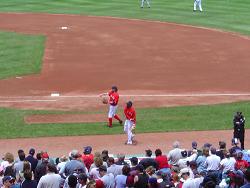 Sports Law Blog reader Will Li passes on news from the State of Washington, where a state appellate court in Taylor v. Baseball Club of Seattle (Mariners) upheld a trial court's ruling that a Mariners fan who was struck in the face with a pregame warm-up toss had assumed the risk. The injury happened in 2000. Specifically, about two hours before a Mariners-Rangers game, Delinda Middleton-Taylor was standing in the fourth row down the right-field line. She was trying to locate seats for herself, her two sons, and her boyfriend. At that moment, a throw by Jose Mesa overshot its target--Freddy Garcia--and it directly hit Taylor's eyeglasses, shattering them, and causing pieces of glass to cut into her cornea. To this day, she continues to suffer from blurry vision (for more background, see Peter Lewis, "Appeals Court Rejects Claim of Injured M's Fan," Seattle Times, Mar. 1, 2006).
Sports Law Blog reader Will Li passes on news from the State of Washington, where a state appellate court in Taylor v. Baseball Club of Seattle (Mariners) upheld a trial court's ruling that a Mariners fan who was struck in the face with a pregame warm-up toss had assumed the risk. The injury happened in 2000. Specifically, about two hours before a Mariners-Rangers game, Delinda Middleton-Taylor was standing in the fourth row down the right-field line. She was trying to locate seats for herself, her two sons, and her boyfriend. At that moment, a throw by Jose Mesa overshot its target--Freddy Garcia--and it directly hit Taylor's eyeglasses, shattering them, and causing pieces of glass to cut into her cornea. To this day, she continues to suffer from blurry vision (for more background, see Peter Lewis, "Appeals Court Rejects Claim of Injured M's Fan," Seattle Times, Mar. 1, 2006).
Taylor asserted that such an injury had never been documented before in a major league baseball game, and thus it was impossible for her to have assumed its risk. She also argued that the Mariners failed to incorporate warm-up methods used by other teams, and that they should have had a formal policy prohibiting pitchers from practicing near the stands.
The Mariners argued that their duty to protect spectators from balls entering the stands was satisfied by providing a protective screen behind home plate and Taylor--who had already been to Safeco field in the past and had watched Mariners game on TV--was familiar with baseball, Safeco Field, and the inherent risk of balls entering the stands, and therefore had assumed the risk of her injury.
The appellate court agreed with trial court's granting of summary judgment for the Mariners. The Mariners showed that Taylor had a "full subjective understanding of the specific risk, both its nature and presence, and that she voluntarily chose to encounter the risk." In making this conclusion, the court noted (and I added the numbering for clarity):
1. [I]t is undisputed that the warm-up is part of the sport, that spectators such as Taylor purposely attend that portion of the event, and that the Mariners permit ticket-holders to view the warm-up. Therefore, we reject Taylor's attempt to delineate between portions of the event and assign varying standards of care to the defendant . . . warm-ups are integral to the game of baseball and a spectator assumes the risk of being struck by a baseball during warm-ups.Will Li asks some good follow-up questions:
2. There is no evidence that the circumstances leading to Taylor's injury constituted an unusual danger. It is undisputed that it is the normal, every-day practice at all levels of baseball for pitchers to warm up in the manner that led to this incident. The risk of injuries such as Taylor's are within the normal comprehension of a spectator who is familiar with the game. Indeed, the possibility of an errant ball entering the stands is part of the game's attraction for many spectators.
3. [As] to whether the risk of injury would be foreseeable to a reasonable person with Taylor's familiarity with baseball, the record contains substantial evidence regarding Taylor's familiarity with the game. She attended many of her sons' baseball games, she witnessed balls entering the stands, she had watched Mariners' games both at the Kingdome and on television, and she knew that there was no screen protecting her seats, which were close to the field. In fact, as she walked to her seat she saw the players warming up and was excited about being in an unscreened area where her party might get autographs from the players and catch balls.
It's interesting that she was hit when standing in the fourth row of right field - the article says that it's uncertain if Freddy Garcia, the target of Mesa's throw, was able to touch the ball, but you really have to wing a ball to get it up in the fourth row, and at that point, it's unlikely that the target of the throw is going to be able to get anywhere near it.So who was in the best position to prevent the harm: Taylor or the Mariners? And what was the significance of the injury being a "fluke" -- couldn't that cut both ways? As to Taylor not suing Mesa (or Garcia), that is an interesting point, and I suspect it is because Mesa would argue that he was reasonably performing his employment functions, and that an accident simply occurred. But I wonder why Taylor didn't sue her eyeglass company -- aren't most eyeglasses supposed to be "shatter proof" or I am wrong about that?
Would the woman have been better of suing Mesa and not the Mariners, since the action involved wasn't actually part of a game?





0 comments:
Post a Comment